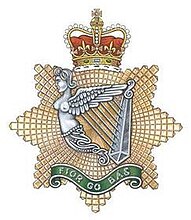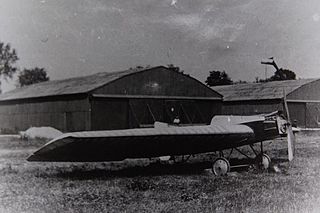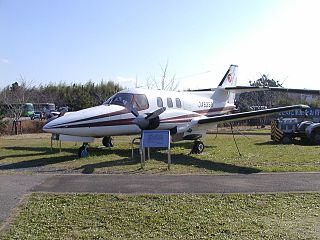The United States Navy, United States Coast Guard, and United States National Oceanic and Atmospheric Administration (NOAA) use a hull classification symbol to identify their ships by type and by individual ship within a type. The system is analogous to the pennant number system that the Royal Navy and other European and Commonwealth navies use.
The Aircraft Manufacturing Company Limited (Airco) was a British aircraft manufacturer operating from 1912 to 1920. Airco produced thousands of aircraft for the British military during the First World War, most of which were designed by their chief designer, Geoffrey de Havilland. Advertised in 1918 as the largest aircraft company in the world, Airco established the first airline in the United Kingdom, Aircraft Transport and Travel Limited, as a subsidiary. A glut of war surplus aircraft and a lack of government interest in aviation caused the company to become unprofitable, and in 1920 it was sold to Birmingham Small Arms Company, who had its operations liquidated later that year.

Skywriting is the process of using a small aircraft, able to expel special smoke during flight, to fly in certain patterns that create writing readable by someone on the ground. The message is often a frivolous phrase, a generally meaningless greeting, or an advertisement aimed at everyone in the vicinity, a general public display of celebration or goodwill, or a personal message, such as a marriage proposal or birthday wish.

The Dassault Mirage 2000 is a French multirole, single-engine fourth-generation jet fighter manufactured by Dassault Aviation. It was designed in the late 1970s as a lightweight fighter to replace the Mirage III for the French Air Force. The Mirage 2000 evolved into a multirole aircraft with several variants developed, with sales to a number of nations. It was later developed into the Mirage 2000N and 2000D strike variants, the improved Mirage 2000-5 and several export variants. Over 600 aircraft were built and it has been in service with nine nations.

The Air Department of the British Admiralty later succeeded briefly by the Air Section followed by the Air Division was established prior to World War I by Winston Churchill to administer the Royal Naval Air Service.

The AD Flying Boat was designed by the British Admiralty's Air Department to serve as a patrol aircraft that could operate in conjunction with Royal Navy warships. Intended for use during the First World War, production of the aircraft was terminated as the end of the war came into sight, and the type saw little operational use. A number were repurchased after the end of the war by Supermarine Aviation and rebuilt as civil transports, becoming known as the Supermarine Channel.

An air speed record is the highest airspeed attained by an aircraft of a particular class. The rules for all official aviation records are defined by Fédération Aéronautique Internationale (FAI), which also ratifies any claims. Speed records are divided into multiple classes with sub-divisions. There are three classes of aircraft: landplanes, seaplanes, and amphibians; then within these classes, there are records for aircraft in a number of weight categories. There are still further sub-divisions for piston-engined, turbojet, turboprop, and rocket-engined aircraft. Within each of these groups, records are defined for speed over a straight course and for closed circuits of various sizes carrying various payloads.

The 2nd Battalion, Irish Regiment of Canada is a Primary Reserve infantry regiment of the Canadian Army based in Sudbury, Ontario. It is part of the 4th Canadian Division's 33 Canadian Brigade Group.

Florence Airport, Peretola, Italian: Aeroporto di Firenze-Peretola and formally Amerigo Vespucci Airport, is the international airport of Florence, the capital of the Italian region of Tuscany. It is the second-busiest Tuscan airport in terms of passengers after Pisa International Airport. It serves as a focus city for Vueling.

The Air Force and Air Defence, was one of three branches of the Yugoslav People's Army, the Yugoslav military. Commonly referred-to as the Yugoslav Air Force, at its height it was among the largest in Europe. The branch was disbanded in 1992 after the Breakup of Yugoslavia.

The NASA AD-1 was both an aircraft and an associated flight test program conducted between 1979 and 1982 at the NASA Dryden Flight Research Center, Edwards California, which successfully demonstrated an aircraft wing that could be pivoted obliquely from zero to 60 degrees during flight.

Between 1920 and 1951 the Société des Moteurs Salmson in France developed and built a series of widely used air-cooled aircraft engines.
Hewlett & Blondeau was a manufacturer of aeroplanes and other equipment based in Leagrave, Luton, England which produced more than 800 aeroplanes and employed up to 700 people.

The Dewoitine D.7 was a French sport plane built in the mid 1920s.

The Fuji/Rockwell Commander 700 is a light transport airplane. It was a joint Japanese-American development between Fuji Heavy Industries and Rockwell International. When Rockwell sold off the general aviation division the agreement was terminated.

British Salmson aero-engines refers to a series of small French designed, air-cooled radial aero engine that were produced by British Salmson, under license from Société des Moteurs Salmson, in Great Britain during the late 1920s and 1930s.

Ad Astra Aero was a Swiss airline based at Zürichhorn in Zürich.

Southwest Airlines Flight 812 was a passenger flight which suffered rapid depressurization at 34,400 ft (10,485 m) near Yuma, Arizona, leading to an emergency landing at Yuma International Airport, on April 1, 2011. The incident caused documented minor injuries to two of the 123 aboard. The aircraft involved, a Boeing 737–300, was operating Southwest Airlines' domestic scheduled service from Phoenix Sky Harbor International Airport, Phoenix, Arizona, to Sacramento International Airport, Sacramento, California.
The depressurization was caused by the structural failure of a lap joint in the fuselage skin due to metal fatigue. The aircraft made an emergency descent, and after landing, was found to have a hole approximately 60 inches (150 cm) long on top of the fuselage above the passenger cabin. The NTSB investigation revealed evidence of pre-existing fatigue, and determined the probable cause of the incident to be related to an error in the manufacturing process for joining fuselage crown skin panels. This incident led to the FAA increasing the inspection rate of certain airframes. The incident followed a similar one, Southwest Airlines Flight 2294, in 2009.

No. 3 Aircraft Depot was a maintenance unit of the Royal Australian Air Force (RAAF). Formed in March 1942 at RAAF Station Amberley, Queensland, its prime function initially was the assembly and despatch of combat aircraft from the United States; it also performed salvage operations. From 1942 until 1947 it took on the role of administering the Amberley base. The depot was responsible for heavy maintenance of the RAAF's English Electric Canberra jet bombers following their entry into service in 1953. In the 1970s it began maintaining and upgrading the General Dynamics F-111C swing-wing bomber, along with Bell UH-1 Iroquois and Boeing CH-47 Chinook helicopters. No. 3 AD merged with No. 482 Maintenance Squadron in March 1992 to form No. 501 Wing, which maintained the F-111 until disbanding in 2001.

















